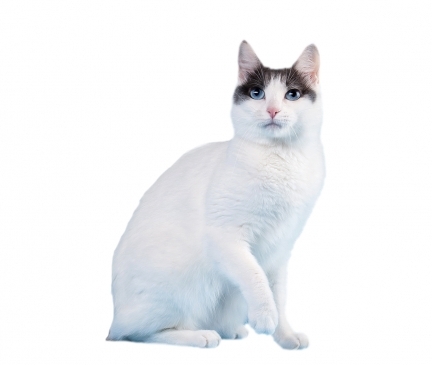

Japanese Bobtail Cat Breed Description
Japanese Bobtail Traits At A Glance
Active
Playful
Requires Attention
Affectionate
Vocal
Docile
Intelligent
Independent
Health
Grooming
Child Friendly
Pet Friendly
Size: Japanese Bobtail cats are medium in size and range in size from 5 to 10 pounds.
Characteristics: The Japanese Bobtail is medium in size and has a muscular and slim body. They are known for their distinct bobtail. The tail is typically about 3 to 4 inches long and can be flexible or rigid. Many tails curl, making them appear shorter than they are. They have long, triangular heads with high foreheads, high cheekbones and large, oval eyes that can be any color and may even be two different colors.
Temperament: There is a reason the Japanese Bobtail has been well loved for 1,000 years. They are active, lively and intelligent cats. They are incredibly vocal cats and will happily chat your ear right off. They are curious and happily interact with strangers. They are affectionate and loving and make wonderful companions. And when they aren't having a chat or cuddling someone they love, they are playing and staying busy. They play fetch, play with toys, play with water, prance and jump around. They will entertain you all day and quickly become your best friend.
Care: The Japanese Bobtail is an easy to love and easy to care for breed of cat. Their coat simply requires brushing or combing 1 to 2 times each week and slightly more often during seasons of shedding. Other standard regular grooming such as nail trimming and ear cleaning will be needed to keep your cat looking as beautiful as it deserves. Additionally, brush your cat's teeth regularly to prevent periodontal disease.
Coat: The Japanese Bobtail comes in both longhair and shorthair varieties. The shorthair variety does not have an undercoat but a medium length coat that lies flat against their body. The longhair variety has a longer coat that feels soft and silky. They also have belly shad and britches on their hindquarters. The coats can come in avariety of colors and patterns but the most common is the Mi-Ke.
Origin: The history of the Japanese Bobtail is shrouded in mystery and folklore but we know that it has existed for at least 1,000 years. It is one of the oldest existing cat breeds in the world. In the 6th century, domestic cats made their way into Japan by way of China and Korea. They traveled by ship and were likely used to help protect goods from damage by rodents that were commonly on ship. It is unknown whether or not they had their signature bobtails that they are known for today. They moved from just being skilled mousers to being admired beautiful creatures over time.
Woodcut prints, written records and silkscreen paintings from as early as the 1600s depict cats with similar appearances and bobtails. But, when the silk industry in Japan became threatened by a widespread population of rats, the skillful Japanese Bobtail cats were employed to help keep the rodent population at bay. Japanese Bobtail's saved silkworms and effectively helped save the silk industry. Even though the Japanese Bobtail cat breed has been around for centuries, they have only been in the United States for a relatively short time. The breed made its way to the United States when Abyssinian breeder Elizabeth Freret fell in love with a Japanese Bobtail at a cat show and decided to import the breed from Japan. It was quite a long process but with the help of fellow breeder Judy Crawford, who lived in Japan at the time, and CFA Japanese Judge Beth Higuchi, Elizabeth Freret was able to obtain 3 Japanese Bobtail kittens that would go on to be the foundation of the breed for the United States.
The three kittens were a Mi-Ke female (the name for a Japanese Bobtail kitten born with a unique and particular pattern of red, white and black markings), a red and white male, and a cinnamon tabby female. Around the same time, another breeder named Lynn Beck, imported a number of Japanese Bobtail kittens as well. Elizabeth Freret and Lynn Beck promoted the breed and helped make the breed what it is today. They co-wrote the breed standard and co-founded the Japanese Bobtail Cat Club. They were able to recruit more breeders interested in the beautiful breed, imported more cats and expanded the breed's gene pool. As more fanciers became intrigued by the lovely breed, acceptance in the cat fancy world began. In 1969, the CFA accepted Japanese Bobtails for registration and granted championship status in 1976. The Japanese Bobtail breed is now widely respected and accepted by all major associations.

